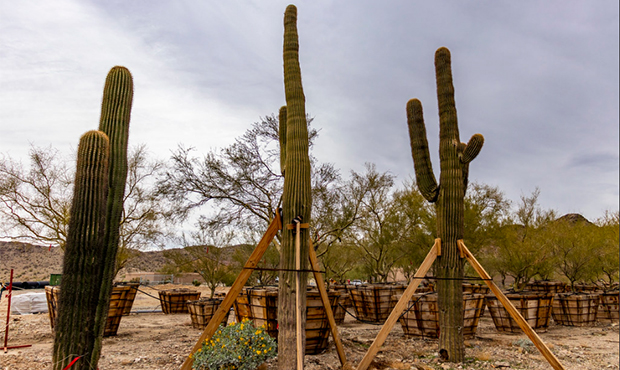Saguaro cactuses relocated for South Mountain Freeway
Saguaro cactuses relocated for South Mountain Freeway

The Arizona Department of Transportation has transplanted thousands of saguaro cactuses during construction projects. Through decades of practice, the agency has developed many successful techniques for salvaging these iconic cactuses.
Last week, I shadowed a five-man crew, working on the Loop 202 South Mountain Freeway project to learn more about this process. In less than two hours, a team of landscapers dug up and moved a 10-foot-tall saguaro near Pecos Road to its home for the next three years: a nursery that will hold salvaged plants until they are replanted prior to the freeway opening by the end of 2019.
The plant salvage process started months ago when landscapers investigated the health of native plants in the freeway's path. In the case of cactuses, those that were good candidates for relocation were tagged. Cactuses that weren't deemed healthy or were growing in rock or other conditions that make them unlikely to survive transplantation aren't being moved.
With the aid of a large backhoe and several shovels, the crews I shadowed carefully dug up the saguaro, exposing the roots. While this was occurring, one crew member sprayed the ground with water to keep dust down. A truck equipped with a boom lift and cradle secured the saguaro in an upright position. Padding in the cradle ensures that the cactus isn't scraped and scarred during the move.
The truck boom then lowered the saguaro into its temporary home.
Workers then dug up a hole and placed the saguaro facing the same direction as it was before and at the same depth as its former home. ADOT has learned that planting a saguaro too deep can affect its survivability. At the base of the roots, the crew added sulfur and sand to help the saguaro take root. Finally, they compacted the ground around the saguaro.
In the next three years, landscapers will monitor the saguaro and spacing between the ribs, making sure it has enough water. When the freeway is nearly complete, the saguaro will be planted within the freeway footprint and will add to the scenery for decades to come.
